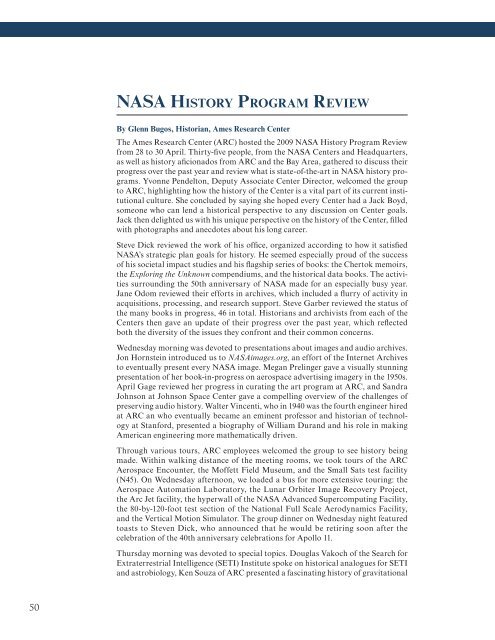FROM THE CHIEF HISTORIAN BORIS CHERTOK'S Rockets and ...
FROM THE CHIEF HISTORIAN BORIS CHERTOK'S Rockets and ...
FROM THE CHIEF HISTORIAN BORIS CHERTOK'S Rockets and ...
Create successful ePaper yourself
Turn your PDF publications into a flip-book with our unique Google optimized e-Paper software.
nasa history division<br />
50<br />
nasa history Program review<br />
By Glenn Bugos, Historian, Ames Research Center<br />
The Ames Research Center (ARC) hosted the 2009 NASA History Program Review<br />
from 28 to 30 April. Thirty-fve people, from the NASA Centers <strong>and</strong> Headquarters,<br />
as well as history afcionados from ARC <strong>and</strong> the Bay Area, gathered to discuss their<br />
progress over the past year <strong>and</strong> review what is state-of-the-art in NASA history programs.<br />
Yvonne Pendelton, Deputy Associate Center Director, welcomed the group<br />
to ARC, highlighting how the history of the Center is a vital part of its current institutional<br />
culture. She concluded by saying she hoped every Center had a Jack Boyd,<br />
someone who can lend a historical perspective to any discussion on Center goals.<br />
Jack then delighted us with his unique perspective on the history of the Center, flled<br />
with photographs <strong>and</strong> anecdotes about his long career.<br />
Steve Dick reviewed the work of his offce, organized according to how it satisfed<br />
NASA’s strategic plan goals for history. He seemed especially proud of the success<br />
of his societal impact studies <strong>and</strong> his fagship series of books: the Chertok memoirs,<br />
the Exploring the Unknown compendiums, <strong>and</strong> the historical data books. The activities<br />
surrounding the 50th anniversary of NASA made for an especially busy year.<br />
Jane Odom reviewed their efforts in archives, which included a furry of activity in<br />
acquisitions, processing, <strong>and</strong> research support. Steve Garber reviewed the status of<br />
the many books in progress, 46 in total. Historians <strong>and</strong> archivists from each of the<br />
Centers then gave an update of their progress over the past year, which refected<br />
both the diversity of the issues they confront <strong>and</strong> their common concerns.<br />
Wednesday morning was devoted to presentations about images <strong>and</strong> audio archives.<br />
Jon Hornstein introduced us to NASAimages.org, an effort of the Internet Archives<br />
to eventually present every NASA image. Megan Prelinger gave a visually stunning<br />
presentation of her book-in-progress on aerospace advertising imagery in the 1950s.<br />
April Gage reviewed her progress in curating the art program at ARC, <strong>and</strong> S<strong>and</strong>ra<br />
Johnson at Johnson Space Center gave a compelling overview of the challenges of<br />
preserving audio history. Walter Vincenti, who in 1940 was the fourth engineer hired<br />
at ARC an who eventually became an eminent professor <strong>and</strong> historian of technology<br />
at Stanford, presented a biography of William Dur<strong>and</strong> <strong>and</strong> his role in making<br />
American engineering more mathematically driven.<br />
Through various tours, ARC employees welcomed the group to see history being<br />
made. Within walking distance of the meeting rooms, we took tours of the ARC<br />
Aerospace Encounter, the Moffett Field Museum, <strong>and</strong> the Small Sats test facility<br />
(N45). On Wednesday afternoon, we loaded a bus for more extensive touring: the<br />
Aerospace Automation Laboratory, the Lunar Orbiter Image Recovery Project,<br />
the Arc Jet facility, the hyperwall of the NASA Advanced Supercomputing Facility,<br />
the 80-by-120-foot test section of the National Full Scale Aerodynamics Facility,<br />
<strong>and</strong> the Vertical Motion Simulator. The group dinner on Wednesday night featured<br />
toasts to Steven Dick, who announced that he would be retiring soon after the<br />
celebration of the 40th anniversary celebrations for Apollo 11.<br />
Thursday morning was devoted to special topics. Douglas Vakoch of the Search for<br />
Extraterrestrial Intelligence (SETI) Institute spoke on historical analogues for SETI<br />
<strong>and</strong> astrobiology, Ken Souza of ARC presented a fascinating history of gravitational
















